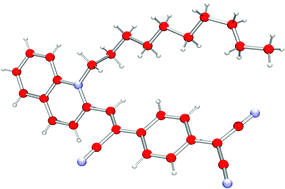Comparison of the structure property relationships in LB films of zwitterionic TCNQ adducts
Abstract
Substitution reactions of TCNQ (

Maintenance work is planned for Wednesday 1st May 2024 from 9:00am to 11:00am (BST).
During this time, the performance of our website may be affected - searches may run slowly and some pages may be temporarily unavailable. If this happens, please try refreshing your web browser or try waiting two to three minutes before trying again.
We apologise for any inconvenience this might cause and thank you for your patience.
* Corresponding authors
a
Materials Research Institute, Sheffield Hallam University, Howard Street, Sheffield, UK
E-mail:
norman.bell6@btopenworld.com.
Fax: +44 114 2253 066
Tel: +44 114 2253 002
b Health and Safety Laboratory, Health and Safety Executive, Broad Lane, Sheffield, UK
c Department of Chemistry, University of Southampton, Highfield, Southampton, UK
d The University of Sydney, School of Chemistry, F11, NSW 2006, Australia
e Physical Electronics and Fibre-optics Research Laboratories, School of Engineering, Sheffield Hallam University, Howard Street, Sheffield, UK
Substitution reactions of TCNQ (

 Please wait while we load your content...
Something went wrong. Try again?
Please wait while we load your content...
Something went wrong. Try again?
N. A. Bell, C. S. Bradley, R. A. Broughton, S. J. Coles, D. E. Hibbs, M. B. Hursthouse, A. K. Ray, D. J. Simmonds and S. C. Thorpe, J. Mater. Chem., 2005, 15, 1437 DOI: 10.1039/B414325F
To request permission to reproduce material from this article, please go to the Copyright Clearance Center request page.
If you are an author contributing to an RSC publication, you do not need to request permission provided correct acknowledgement is given.
If you are the author of this article, you do not need to request permission to reproduce figures and diagrams provided correct acknowledgement is given. If you want to reproduce the whole article in a third-party publication (excluding your thesis/dissertation for which permission is not required) please go to the Copyright Clearance Center request page.
Read more about how to correctly acknowledge RSC content.
 Fetching data from CrossRef.
Fetching data from CrossRef.
This may take some time to load.
Loading related content
